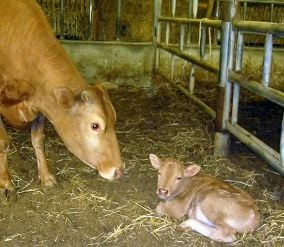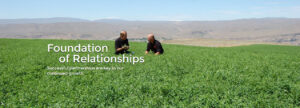The four-chambered ‘stomach’ of a ruminant (cow, sheep, goat) is very efficient at turning high-fiber feed sources into fuel for growth, meat, and milk production. A calf is born with the same four-chambered stomach as an adult cow, but it develops and changes as the calf grows and eats different things. When a calf suckles, milk flows through the esophageal groove directly into the abomasum, which is the functional compartment of the ruminant stomach at birth. Milk is digested with enzymes in the abomasum, similar to the digestion process that occurs in the human stomach. Solid food and water go into the rumen, a fermentation vat that is undeveloped and inactive in young calves. The rumen must become populated with the microbes that will eventually ferment fibrous and dry feeds. Microbial development occurs as the calf interacts with its environment. Additionally, the inactive rumen must enlarge, the muscular layer of the rumen wall must develop, and papillae, which are small finger-like projections, must form and elongate on the inside, or mucosal layer, of the rumen before it becomes a functioning organ. Therefore, care must be taken to feed a calf correctly to optimize ruminal development in preparation for weaning.
There is some controversy regarding what type of solid feed to give a calf before weaning. Generally, offering forage while the calf is fed milk is discouraged because forage ingestion may decrease grain intake. Feeding a grain or starter feed is usually recommended because the fermentation end products of these types of feeds stimulate papillae growth. In addition, concentrate feeds are more energy dense and support greater body weight gain in calves. However, ingestion of forages stimulates muscular development of the rumen wall, promotes rumen health, and decreases the incidence of undesirable oral behaviors. Several current studies suggest that adding forage to a calf’s diet may be beneficial.
A recent study published by a research group in Spain evaluated the effects of providing chopped forage to the diet of young calves from 2 weeks of age to weaning (1). Holstein calves that were fed milk replacer, starter feed and forage gained the same or more than calves fed milk replacer and starter feed only. Furthermore, addition of forage to the diet did not decrease consumption of starter feed compared to calves that were not provided forage. Calves that were fed chopped alfalfa hay also spent less time expressing undesirable oral behaviors such as licking, tongue rolling or consuming bedding material. Canadian scientists conducted a similar study and found that the addition of chopped orchard grass hay to the diets of calves fed large quantities of milk and calf starter aided rumen development (2).
Results from both scientific studies provide evidence that adding forage to the diet of young calves is not detrimental (and may actually be beneficial) to rumen development as long as concentrate is also provided. Moreover, addition of forage does not decrease consumption of concentrate or affect subsequent body weight gain. Lastly, providing forage such as chopped alfalfa hay may reduce boredom and decrease incidence of stereotypy behavior in calves.
The addition of forage to a calf’s diet has been shown to improve overall health and behavior. Do you feed chopped forage to your calves? How do you integrated forage into your feed program for calves? Please share your thoughts and comments below.
To recieve these blog posts via email, please subscribe in the box to the upper right.
References
(1) Castells, L.I., A. Bach, G. Araujo, C. Montoro, and M. Terre. 2012. Effect of different forage sources on performance and behavior of Holstein calves. J. Dairy Sci. 95:286-293.
(2)Khan, M.A., D.M. Weary, and M.A.G. von Keyserlingk. 2011. Hay intake improves performance and rumen development of calves fed higher quantities of milk. J. Dairy Sci. 94:3547-3553.


